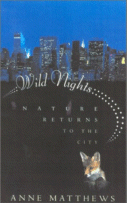Wild Nights : Nature Returns to the City
North Point Press, May, 2001.
Hardcover, 207 pages.
ISBN: 0865475601
 One would have thought that the subject of New York
would have been exhausted by now. Books and
articles have chronicled the history, the citizens, the
architecture, the literature and the influence of the city
from all different viewpoints. Yet Ms. Mathews has come
up with a unique view of the city and its future from her
study of its relationship to wildlife and of wildlife's relation
to the city. For those who think that only pigeons and rats
are really adapted to life in the city this book will be a revelation.
One would have thought that the subject of New York
would have been exhausted by now. Books and
articles have chronicled the history, the citizens, the
architecture, the literature and the influence of the city
from all different viewpoints. Yet Ms. Mathews has come
up with a unique view of the city and its future from her
study of its relationship to wildlife and of wildlife's relation
to the city. For those who think that only pigeons and rats
are really adapted to life in the city this book will be a revelation.
Many a suburbanite and some city dwellers have been startled on their early morning jogs at seeing a coyote trotting down a street as if it were in its natural habitat. On occasion, homeowners have been surprised to see a huge hawk devouring the remnants of a squirrel it had clearly killed. Grandparents have discovered that raccoons had savaged the grandchildren's wading pool overnight or had decided on winter quarters in the attic. The deer in some exclusive neighborhoods have dined on thousands of dollars worth of landscaping, and hapless small pets have become meals for nameless predators. Yet most of us feel that these are isolated incidents, sometimes entertaining and sometimes upsetting. If a young jogger is attacked on her early morning run near a posh California development, it is dismissed as a rare tragedy that probably will not be repeated. Nothing could be further from the truth. Developers are invading ancient habitats of predators. We don't expect this sort of thing to be happening in Manhattan, but actually some of this is occurring right outside our doors.
Wild Nights is divided into a compelling and not-to-be-skipped introduction, "Sky and Water," "Leaf and Stone" and "Day and Night." The section entitled "Leaf and Stone" is very alarming as it recounts the almost weekly dangerous encounters that both city dwellers and suburbanites are experiencing. The main difficulty is that urbanized people no longer understand the habits of wild creatures. Parents of young children, as well as pet owners and early morning joggers, are becoming increasingly aware that there is more to fear than muggers in the early dawn or at dusk or after dark. Encounters can be shocking for city dwellers, but wildlife is adapting to the change in their environments with a loss of fear and an appetite for the easy life that is increasing. It may be amusing to hear tales of the Canadian Geese who no longer care to commute on long boring trips to the winter breeding ground, but what do we do when the memory of how to migrate is not ingrained into the brains of succeeding generations? What will happen when large predators no longer fear Man, but rather have decided to immigrate and enjoy a carefree lifestyle?
It almost seems that while we are watching documentaries that we are not considering what we are seeing. Ancient civilizations in Central America have been taken back by their environments. Wildlife is only cute, endearing and cuddly for about the first three months of life if for that long. Kittens grow up to be cats, but bear cubs grow up to become unpredictable and dangerous bears. As always, knowledge is the best weapon of our species. Ms. Matthews' well-written book imparts that knowledge and should help raise the consciousness about the effect that modern civilization is having on the wildlife that it has displaced. Inhabitants of the New York area are not the only persons who should become familiar with the in-depth and fascinating study that Ms. Matthews has presented to us. Wildlife is still here, and we all need to know more about it.
--Sarah Reaves White
Wild Nights : Nature Returns to the City is available for purchase on Amazon.com
Note: We may receive a commission from sales made through product links in this article.
This review was published in the August, 2001 of The Internet Writing Journal.
Copyright © Writers Write, Inc. All Rights Reserved.
